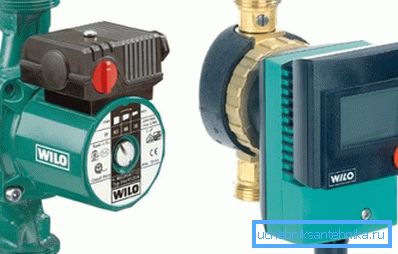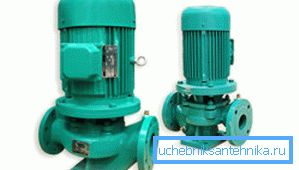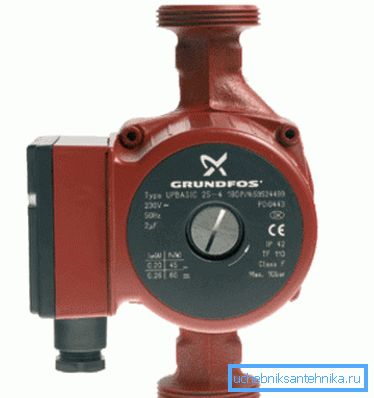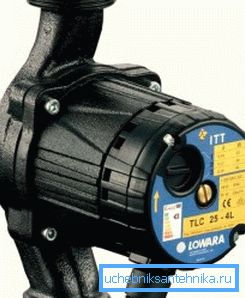How to choose a circulation pump for heating and what to
In small private houses the circulation of the coolant through the heating pipes is carried out in a natural way, however, in large and two-storey buildings such a system is inefficient, as the standard pressure of 0.6 MPa is not enough.
Therefore, to increase the force and rate of circulation of the coolant, a circulation pump is used. Since the efficiency of the heating system depends on this device, it is necessary to approach its choice very responsibly, so in this article we will look at how to choose the circulating pump for the heating system correctly.

Features of the devices
Design
So, before you make an informed choice of a circulating pump for the heating system, you need to learn more about its device. The design of this device is in many ways reminiscent of drainage pumping equipment, however, unlike it, the device is designed to force the transfer of coolant in a closed pipeline system (see also the article Is the floor heating two-pipe heating system of a two-story private house beneficial)
The circulating pump consists of the following main elements:
| Housing | Must be made of stainless material. Most of the body I do from:
|
| Rotor | It can be made of ceramic or steel. |
| Rotor shaft | Equipped with an impeller wheel with blades. |
| Electric motor | Drives the rotor. From the engine power depends on the performance of the device. |

Operating principle
Since the circulating pump is part of a closed loop, the principle of its operation is as follows:
- Through the inlet nozzle absorbs the coolant due to the created vacuum;
- Inside the body, the apparatus accelerates the movement of fluid by rotating the impeller;
- Then the fluid is pushed out of the outlet.
Due to the uniform operation of this equipment, a certain level of pressure is maintained in the system. However, it must be borne in mind that it will be possible to increase it only with the help of a pump.
The function of the circulation apparatus is to overcome the resistance in the pipeline.

Types of units
In order to facilitate the selection of the circulating pump for heating, first of all it is necessary to determine its type.
There are two types of devices on the market today:
- "Wet";
- "Dry."
Below we take a closer look at their features.
Dry
The working part of the rotor of this device is not in contact with the liquid, as it is protected by sealing rings, hence the name. After starting the unit, the rings are set in motion relative to each other.
Among the features of dry type apparatus can be identified:
- High efficiency - 80 percent.
- The service life of moving parts is three years.
- Strong noise during operation, so the device must be installed in a separate room.
Note! When using the apparatus with a “dry” rotor, it is necessary to control the presence of impurities in the pumped coolant and the degree of dustiness of the room. Otherwise, the device may fail.
As a result, dry units are an excellent solution for heating systems of large houses.

Wet
In devices of this type, the working part is immersed in the pumped liquid. In this case, the electrical part is protected by an airtight glass. As a rule, rotors for such devices are made of ceramics, and the body is made of cast iron, bronze or brass.
Among the features of wet-type aggregates are:
- Long service life;
- Easy setup and repair, so that this work is not difficult to do even with your own hands;
- Low noise level;
- Low efficiency (30 percent less than dry).
As a result, such devices are an excellent solution for domestic needs, where it is not required to ensure the circulation of fluid in long-distance pipelines.

Criterias of choice
Before choosing circulating pumps for heating systems, it is necessary to determine their required capacity. It is very simple to do this - it is necessary to equate the power of the heating boiler to the volume of heat carrier transmitted per minute. For example, if the power of a heating installation is 35 kW, 35 liters of fluid will pass through it within a minute.
In addition, it is necessary to determine the coolant flow rate at a certain section of the circuit. To do this, take into account the data on the power of heating batteries. To carry out the necessary calculations, the average velocity of the coolant in the pipeline is assumed to be 1.5 m / s.
Tip! You should not give preference to models, the price of which is the lowest, as it may correspond to the quality of the product.
If, when calculating the power of the device, it turns out that, for example, a pipe section of ten meters needs a pressure of 0.6 m, then a plot of 100 meters will require a pressure of 6 meters, respectively. Having decided on all the parameters, it remains only to find a suitable model.
Italian apparatuses are considered the best:
- DAB;
- Ebara;
- Lowara;

In addition, German Wilo units and Danish Grundfos circulation pumps for heating are a good choice. Domestic manufacturers have also recommended themselves well, however, they focused on the production of industrial devices.
Here, perhaps, is the whole instruction for choosing a circulation pump.
Conclusion
Selecting a suitable circulation pump for heating is easy. To do this, you only need to decide on the type of device that is best suited for a given case, as well as calculate its necessary parameters.
From the video in this article, you can pick up some additional information on this topic.